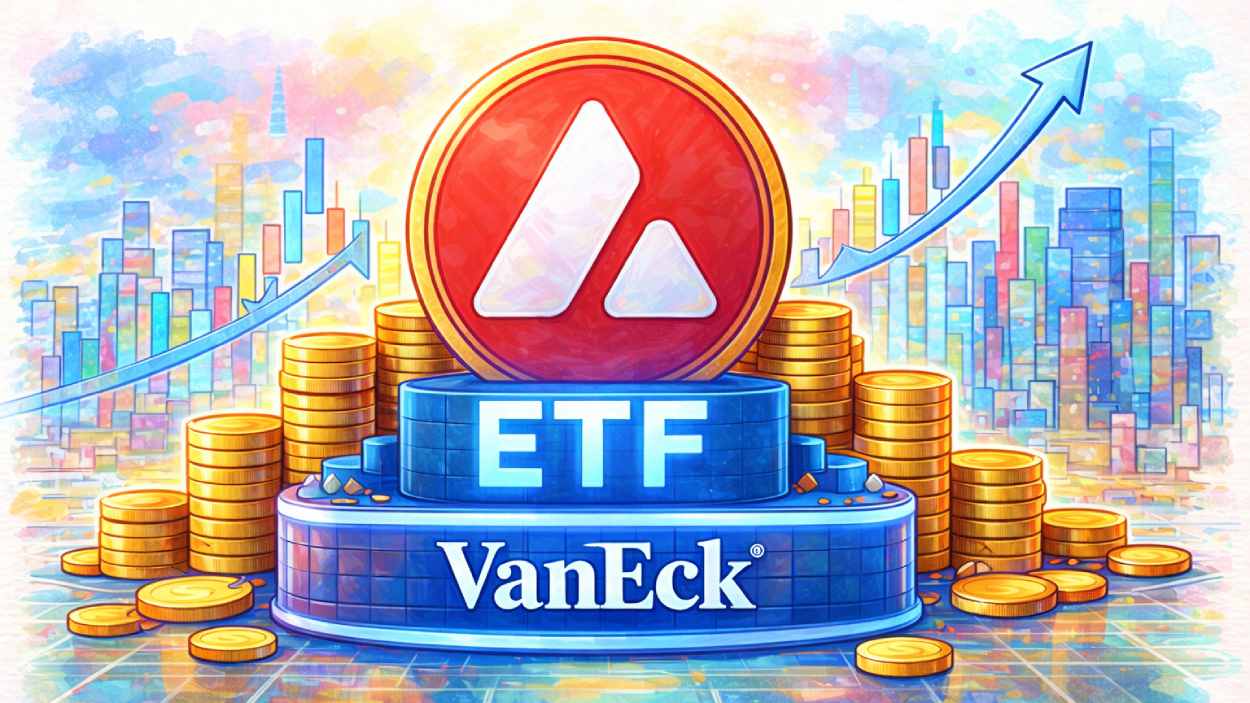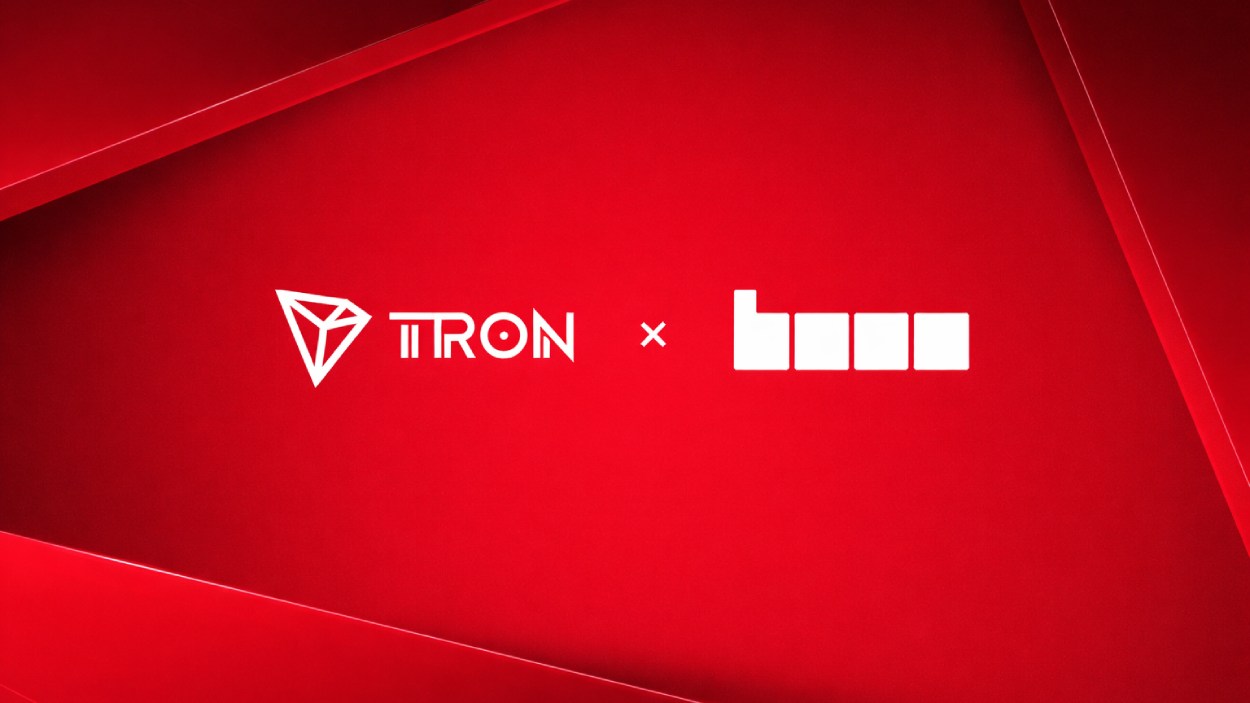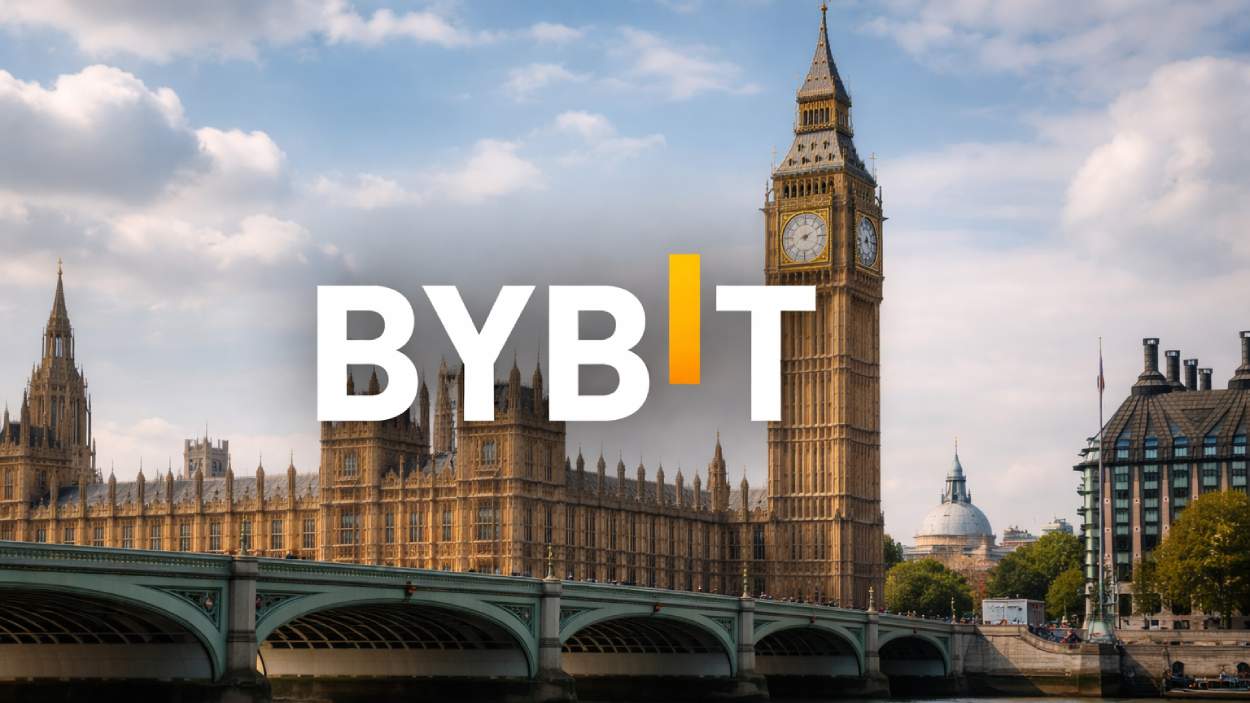The payments ecosystem for e-commerce is evolving rapidly, and one standout player is the built-in solution from Shopify: Shopify Payments. In sectors such as direct-to-consumer retail and small business services, merchants use Shopify Payments both to streamline checkout and to reduce reliance on external gateways.
For example, a U.S. apparel brand on Shopify might cut transaction complexity by using Shopify’s native payments rather than integrating multiple third-party processors. Similarly, a global artisan marketplace can leverage Shopify Payments to offer unified settlement across markets. Below you’ll find a detailed look at Shopify Payments statistics, covering adoption, share, availability, performance, and overall merchant impact.
Editor’s Choice
- 64% of merchants’ gross merchandise value (GMV) processed through Shopify stores used Shopify Payments in Q1 2025.
- Total payment volume via Shopify Payments reached $47.5 billion in Q1 2025, up from about $36.2 billion in Q1 2024.
- Shopify processed approximately $292.3 billion in GMV in 2024, demonstrating its scale as a commerce system.
- As of 2025, 1.89 million merchants actively use Shopify Payments, equal to about 90% of all eligible stores.
- Shopify Payments holds roughly 15% of the payment-processing software market as of 2024.
- The rapid checkout option Shop Pay accounted for 38% of gross payment volume (GPV) in recent reporting.
- Shopify’s merchant stores grew by 6% year-over-year in Q1 2025.
Recent Developments
- In Q1 2025, Shopify’s reported GMV grew 23% year-over-year to ~$74.8 billion.
- Shopify merchant solutions revenue rose ~37% year-over-year in Q2 2025, showing payments business momentum.
- Shopify Payments processed 64% of Shopify’s GMV in Q1 2025, rising from 60% in Q1 2024, with $47.5 billion in payment volume.
- Shop Pay’s GMV jumped by 65% to $27 billion in the period referenced, demonstrating checkout innovation.
- Shopify expanded its payments product into 16 new countries in the referenced year, illustrating geographic rollout.
- Shopify’s business-to-business (B2B) GMV more than doubled in a quarter (101% growth in Q2 2025), which may increase demand for integrated payments.
- The company emphasized cross-border commerce and multi-entity support, pointing to merchants operating globally.
- Shopify achieved seven consecutive quarters of free cash-flow margin in double digits, supporting investment into payments infrastructure.
Shopify Revenue Sources
- Merchant Solutions Revenue accounts for 76% of Shopify’s total income, making it the company’s primary revenue driver.
- This category includes Shopify Payments, Shopify Capital, Shopify Markets, and Shopify Fulfillment, reflecting strong merchant service adoption.
- Subscription Solutions Revenue contributes the remaining 24%, generated from monthly plans, themes, and app subscriptions.
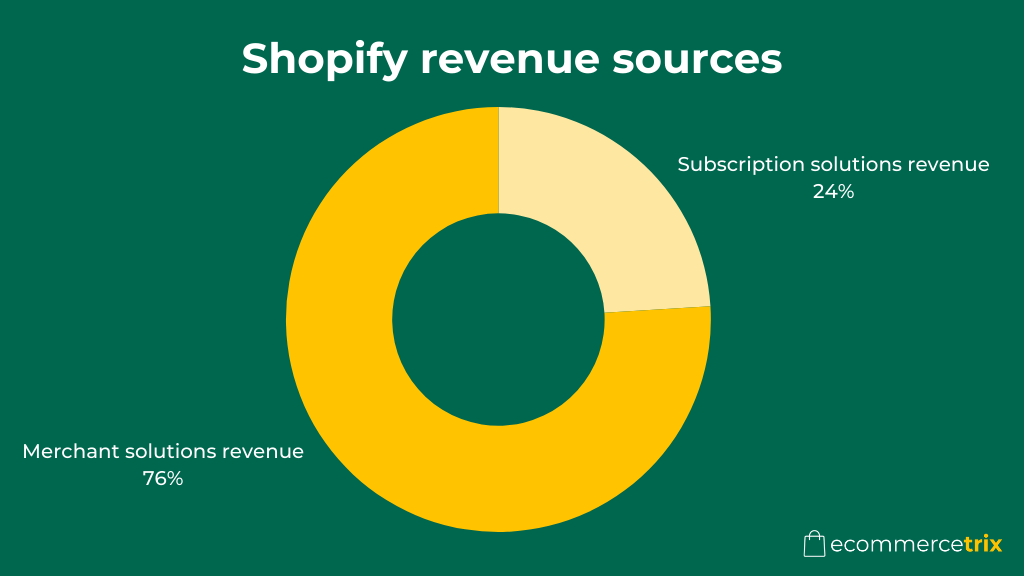
Shopify Payments Adoption Rate
- The previous year (Q1 2024) had around 60% penetration, indicating a ~4-point increase.
- In 2024, Shopify Payments accounted for about 61% of Shopify’s GMV.
- With Shopify’s total GMV of ~$292.3 billion in 2024, roughly $178 billion might be processed via Shopify Payments, implying high transaction volumes.
- The growth of adoption is supported by the fact that Shopify’s merchant count and activity continue to expand, making the native payments option more viable.
- The increasing penetration suggests merchants are shifting from third-party gateways toward Shopify’s built-in payments.
- The “90% of merchants” figure may refer to basic availability rather than full adoption of payment processing.
Shopify Payments Share of Gross Merchandise Volume (GMV)
- In Q1 2025, Shopify Payments processed $47.5 billion, up from $36.2 billion in Q1 2024.
- That $47.5 billion represented ~64% of Shopify GMV for that quarter (since Q1 GMV ~$74.8 billion), indicating strong dominance.
- In 2024 overall, Shopify’s GMV was ~$292.3 billion, and by applying ~61% as the payments share, Shopify Payments may have processed around ~$178 billion.
- Shopify Payments had about a 15% share of the broader payment processing software market in 2024.
- The upward trend in payments share aligns with Shopify’s merchant solutions segment growing faster than subscription revenue.
- The increase in share of GMV suggests that as merchants grow on Shopify, they prefer the integrated payment option for better operational alignment.
- The data points to a strategic shift where Shopify is capturing more of the transaction flow rather than just hosting stores.
- This growth in share may translate into higher revenue for Shopify via processing fees and value-added services associated with payments.
Number of Online Stores Running on Shopify Worldwide
- Apparel dominates Shopify with 537,883 stores, making it the largest product category on the platform.
- Home & Garden follows with 249,536 stores, reflecting strong growth in lifestyle and decor businesses.
- Beauty & Fitness ranks third at 205,097 stores, driven by rising global demand for wellness and personal care products.
- The Food & Drink category hosts 128,035 stores, showcasing the rise of online specialty food brands and delivery-based ventures.
- Social and community-based ventures under People & Society total 78,014 stores, while Sports and Health each maintain over 70,000 stores.
- Art & Entertainment has 71,270 stores, indicating a growing number of independent creators and digital product sellers.
- Niche categories such as Toys & Hobbies (62,505), Autos & Vehicles (44,613), and Pets & Animals (43,400) highlight Shopify’s broad diversification.
- Smaller segments like Computers (32,871), Games (18,473), Books & Literature (14,860), and Travel (10,813) represent emerging but growing industries on the platform.
- The data underscores Shopify’s global versatility, with fashion, lifestyle, and wellness sectors driving the majority of its merchant activity in 2025.
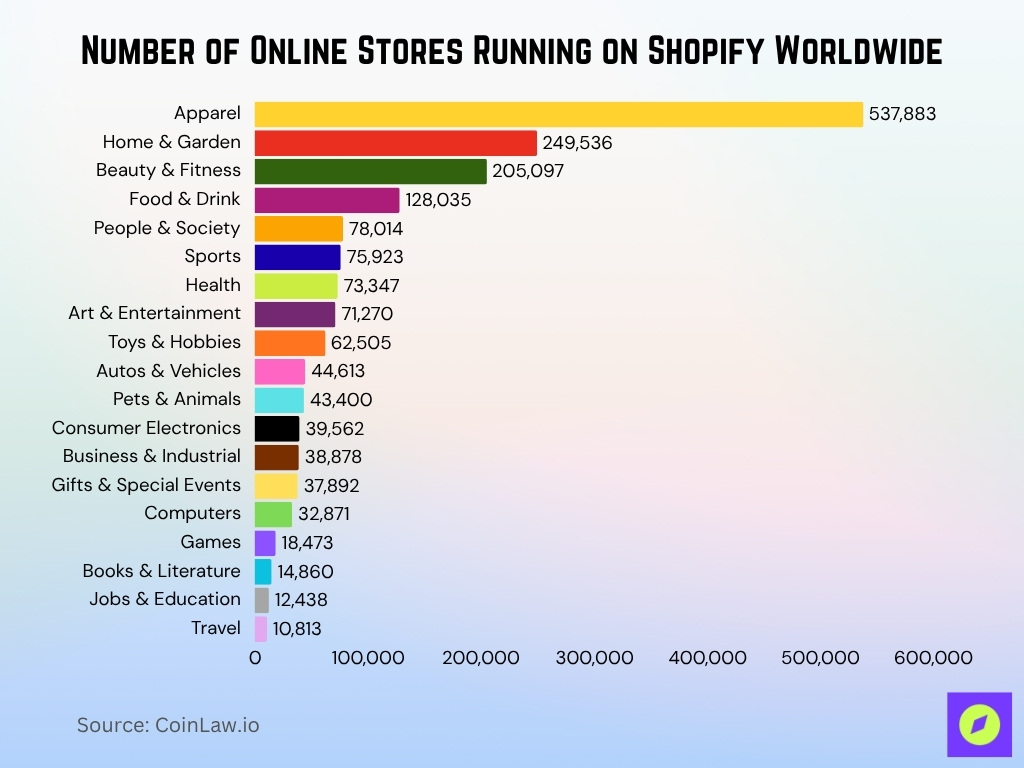
Geographic Availability of Shopify Payments
- Shopify serves merchants in 175+ countries globally.
- In 2025, the payments product was expanded into 16 new countries.
- Shopify Payments is available in 39 countries worldwide as of Q2 2025.
- The U.S. remains the largest single market for Shopify store activity, with ~12% of all U.S. e-commerce flowing through Shopify.
- International GMV for Shopify grew 42% year-over-year in Q2 2025, reflecting strong non-U.S. momentum and the need for multi-market payments.
- Shopify offers multi-entity payout support, helping merchants operating across regions manage local currencies and tax flows.
- The expansion into additional countries reduces friction for merchants migrating to Shopify Payments from third-party gateways, especially in emerging markets.
- Because Shopify Payments’ availability still lags in some regions, merchants may adopt third-party gateways until native support arrives, which suggests room for growth and conversion.
Year-over-Year Growth Trends for Shopify Payments
- The penetration rate of Shopify Payments rose to 64% of the platform’s GMV in Q1 2025, up from ~60% in Q1 2024.
- In Q1 2025, the payment volume processed via Shopify Payments exceeded $47.5 billion, up from ~$36.2 billion in the prior-year period.
- Shop Pay processed 38% of gross payment volume in Q1 2025, up from 33% in 2023
- Shopify’s overall revenue grew 27% year-over-year in Q1 2025, reflecting the expanding payments business.
- The number of live stores using Shopify Pay was ~1.45 million, representing a year-over-year increase of ~14.2%.
- Merchant solutions (which include payments) grew faster than subscription solutions in recent quarters, indicating that payments are a growing segment.
- Merchants are increasingly adopting the integrated payments option rather than third-party gateways.
- Because of the global expansion of availability and improved checkout experience, the growth momentum for Shopify Payments is likely to continue.
Shopify Payments Transaction Fees by Plan
- Merchants on the Shopify plan saw transaction fees for online sales starting at 2.7% + 30¢, with in-person sales at 2.5% + 10¢ when using Shopify Payments.
- For high-volume merchants, Shopify’s Advanced plan reduces online processing fees to ~2.5% + 30¢ when using Shopify Payments.
- When merchants choose not to use Shopify Payments and opt for third-party gateways instead, an additional Shopify fee adds about 1%–2% more in transaction cost.
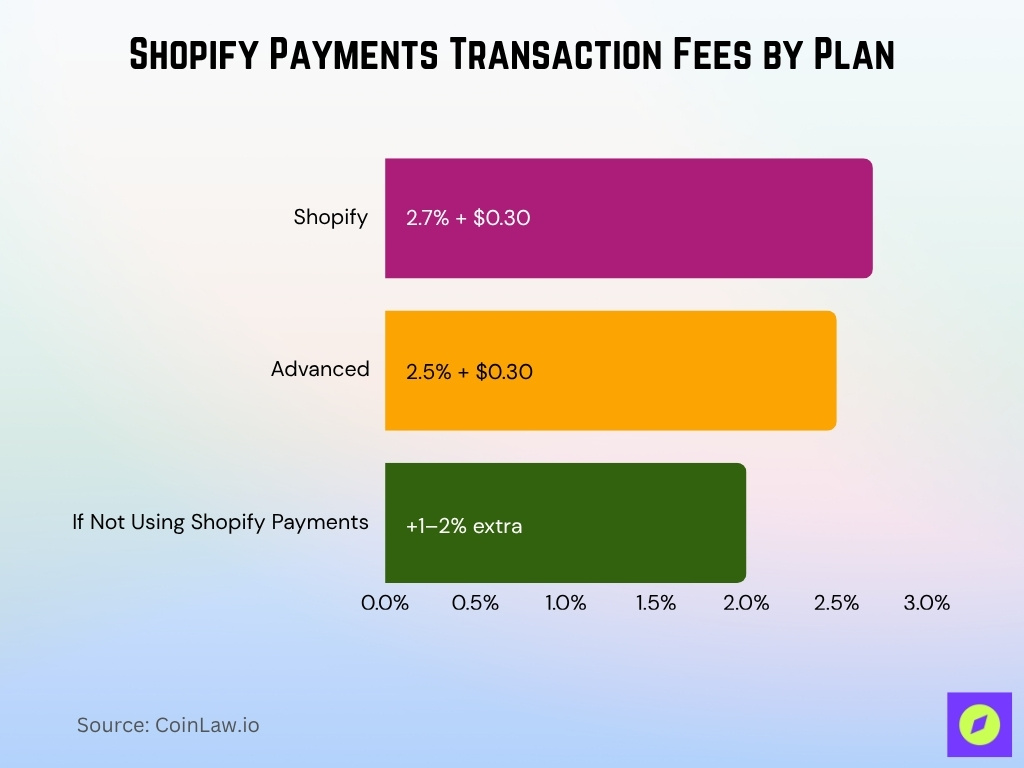
- Shopify Payments becomes cost-effective when monthly GMV exceeds $1,000, due to the elimination of third-party gateway fees.
- Hidden costs such as international transaction markups (+1.5%) and currency conversions can raise effective processing fees to 3.5% or higher for cross-border sales.
- Merchants processing high volumes or with significant international sales may need to evaluate total effective cost, including FX and payout latency.
- Using Shopify Payments often results in 34% lower total cost compared to combining a third-party gateway + Shopify fees.
- Merchants on regional or unsupported plans may face higher rates or non-availability of optimal pricing tiers.
Shopify Payments Adoption by Region
- In the U.S., a majority of merchants on the Shopify platform now use Shopify Payments, with adoption rates up to 90% in supported markets.
- Several markets outside the U.S. still show lower adoption because Shopify Payments is not yet fully available in all countries.
- Of the ~4.8 million active global Shopify stores, ~3 million are U.S.-based, indicating the U.S. remains the largest regional base for payment adoption.
- International GMV for Shopify grew ~42% year-over-year in Q2 2025, underscoring global merchant growth and therefore regional payment adoption potential.
- Regions such as APAC and EMEA are seeing increasing merchant migrations to Shopify, which will boost native payments uptake.
- Some smaller-market merchants still rely on third-party gateways due to eligibility or local constraints, implying regional variation in adoption.
- Multiplying payout and currency features are enhancing regional use of Shopify Payments with multi-entity support.
- While U.S. adoption is very high, emerging markets represent the largest growth opportunity for Shopify Payments adoption globally.
Market Share of Shopify Payments in Payment Processing
- Shopify Payments held about 15% of the global payment-processing software market in 2024.
- Around 90% of eligible merchants use Shopify Payments to process transactions on the platform as of late 2024.
- Shopify Payments processed 62% of all GMV flowing through Shopify in 2024, up from 58% in 2023.
- The solution’s GMV penetration rose to 64% in Q2 2025, marking its highest level yet.
- Shopify Payments handled $43.3 billion in Gross Payments Volume (GPV) during Q3 2024 alone.
- Shopify’s GPV grew 31% year over year in Q3 2024, continuing double-digit growth momentum.
- The platform’s payment capabilities are now available in 40+ countries worldwide.
- Shopify commands 10.32% of the global e-commerce platform market and powers 4.8 million stores globally.
- Merchants using Shopify Payments avoid third-party gateway fees, with savings of roughly 0.5%–2% per transaction.
- Shopify’s payment processing revenue accounts for roughly a 1–2% take rate on total GMV, forming a major growth driver.
Payout Times and Cash Flow with Shopify Payments
- Shopify Payments typically releases funds within 2–5 business days after a charge is processed.
- For U.S. merchants, the average payout time is around 2 business days, faster than many processors.
- Shopify Balance users receive payouts in as little as 1 business day, enabling quicker cash turnover.
- New accounts may face an initial holding period of 7–14 business days before the first payout.
- In countries like the U.K. or New Zealand, standard payout times are 3–5 business days.
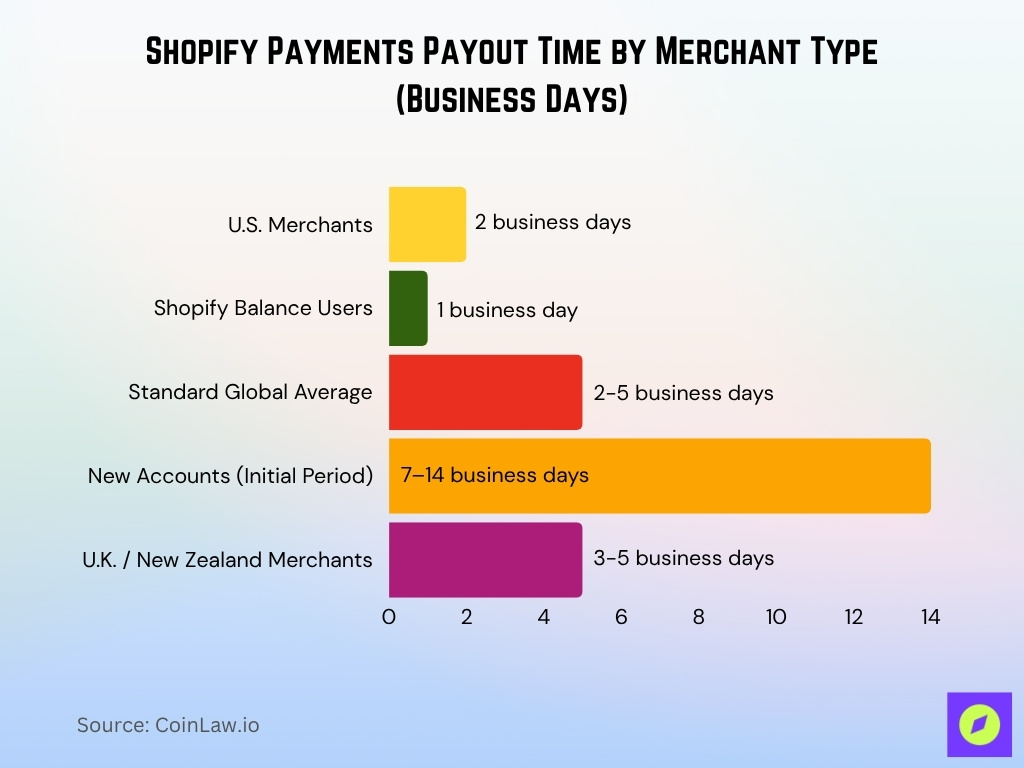
- Shopify merchants can choose payout frequencies, daily, weekly, or monthly, with daily as the default.
- Banks may add 24–72 hours of processing time after Shopify releases funds.
- Shopify’s strong cash metrics included $421 million in free cash flow in Q3 2024, reflecting improved liquidity.
- Payouts are initiated daily at 10 a.m. ET, with previous-day sales deposited first to the Shopify Balance.
Cost Savings from Using Shopify Payments
- Switching from third-party gateway + Shopify fees to Shopify Payments can result in $4,500 annual savings for a monthly GMV of $25,000.
- The example compared a total cost of $1,100 vs $725 using Shopify Payments, yielding ~34% savings.
- The elimination of additional Shopify gateway fees (0.5-2.0%) is a direct savings lever.
- Improved payment success rate from Shopify Payments’ fraud stack drives more revenue, translating into cost avoidance of lost sales and declines.
- Shopify Payments’ 3DS implementation generated ~$471 million in additional annual payment volume by improving success rates.
- Fraud optimization reduced chargeback rates by 20%, saving merchants approximately $62 million annually.
Shop Pay Usage and Performance
- Shop Pay processed ~38% of Shopify’s GPV, up from ~33% in 2023.
- Installs of Shop Pay on e-commerce stores increased by ~14.2% year-over-year.
- About ~1.89 million live websites use Shop Pay, while ~2.63 million sites historically used it.
- Shop Pay users are 77% more likely to make a repeat purchase when using the service.
- Around 43% of customers use Shop Pay as their preferred checkout method when offered.
- 62% of Shop Pay users are Gen Z or Millennials, and over half earn more than $75,000 annually.
- Shopify offers built-in Shop channel reports for detailed measurement of Shop Pay sales and orders.
- Shop Pay is emerging as a key driver of checkout conversion and merchant success within the Shopify ecosystem.
Chargeback Fees and Fraud Protection on Shopify Payments
- Shopify Payments charges a $15 fee per chargeback in the U.S., refundable when merchants win disputes.
- In the U.K., chargebacks cost £10 per case, refunded if resolved in the merchant’s favor.
- 3D Secure (3DS) implementation increased payment success by 0.26% and reduced fraudulent chargebacks by 20%, saving merchants $62 million annually.
- The average chargeback handling cost across e-commerce is about $15–$25 per dispute, excluding lost sales.
- Global ecommerce chargebacks are projected to reach $33.79 billion in 2025, up from $28.7 billion in 2023.
- Fraudulent transaction attempts targeting Shopify stores rose 15% year over year, mirroring broader ecommerce trends.
- Shopify Protect fully covers eligible Shop Pay orders, reimbursing both order value and chargeback fees on fraudulent transactions.
- Third-party fraud platform Signifyd, used by Shopify merchants, reported a 93% reduction in chargebacks for some high-risk clients.
- Merchant chargeback ratios typically average 0.47% of revenue annually from disputes and admin losses.
- Shopify’s machine learning fraud detection scans 100% of transactions in real time to block suspicious activity.
Shopify Payments vs. Third-Party Gateways
- If merchants use third-party gateways instead of Shopify Payments, Shopify charges 0.6% to 2% extra transaction fee.
- Basic plan incurs 2%, Shopify plan 1%, Advanced plan 0.6% per transaction processed externally.
- Shopify Payments offers seamless integration with a unified dashboard; third-party gateways require separate setup and reconciliation.
- Third-party gateways may support more local methods, but increase complexity and cost.
- Shopify Payments lowers total processing cost and eliminates the extra Shopify fee.
- High-volume merchants with global payment needs may still use hybrid approaches after cost-benefit review.
- Merchants report better conversion and fewer declines when using Shopify’s native payments.
- Many U.S. merchants find Shopify Payments financially advantageous unless they need specific local gateways.
The Impact of Shopify Payments on Merchant Success
- Merchants using Shopify Payments report a higher checkout conversion, with over a 50% increase after switching from other processors.
- Improved payment success (0.26% higher approval) adds $471 million in additional payment volume across the ecosystem.
- Lower chargebacks (20% reduction) means merchants retain more revenue.
- Faster and predictable payouts support better cash-flow management.
- Integrated reporting and a unified dashboard reduce administrative burden.
- Multi-region merchants benefit from consistent rates and fewer settlement surprises.
- Transparent fees enable accurate forecasting of margins and profitability.
- Case studies show that migrating to Shopify Payments leads to smoother scaling, fewer hold-ups, and improved profitability.
Key Benefits of Using Shopify Payments
- Merchants using Shopify Payments save up to 2% in extra transaction fees otherwise charged by third-party providers.
- Standard processing fees range between 2.4%–2.9% + $0.30 per transaction, varying by plan tier.
- Businesses on the Basic plan save roughly $12,000 annually by avoiding external processor fees on $50,000 monthly sales.
- Using Shopify Payments unifies order, inventory, and payment tracking across the entire platform for near 100% data sync accuracy.
- Shop Pay checkout converts up to 36% better than competitors, greatly boosting store sales.
- 90%+ of top-performing stores use Shopify Payments for faster settlements and reduced manual accounting effort.
- Shopify Payments supports over 100 global payment methods, including BNPL, wallets, and credit cards.
- Integrated fraud detection and Level 1 PCI DSS security compliance protect millions of transactions monthly.
- Unified dashboards allow merchants to manage 100% of transaction analytics from a single admin interface.
- Multi-currency and global settlement support improve cross-border efficiency by 15–20%, enhancing operational flexibility.
Frequently Asked Questions (FAQs)
16 new countries.
20%.
26 basis points, representing $471 million in additional annual payment volume.
$47.5 billion
Conclusion
Shopify Payments clearly stands as a strategic lever for merchants using the Shopify platform. It offers streamlined payments integration, a favorable cost structure, faster payouts, and robust fraud and chargeback protections. For merchants who qualify and operate in supported regions, the advantages over third-party gateways are substantial, from cash flow to conversion.
That said, eligibility, regional availability, and merchant-specific requirements still matter. As merchants scale and expand globally, choosing the right payment configuration becomes a performance decision, not just a checkbox. If you’re using Shopify, exploring Shopify Payments should be high on your roadmap. You’re now equipped with detailed statistics and insights to evaluate how Shopify Payments may impact your business.






































